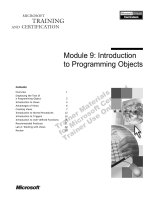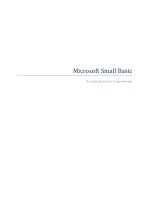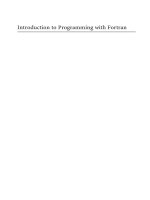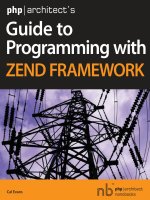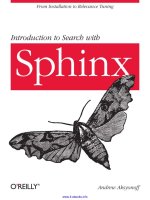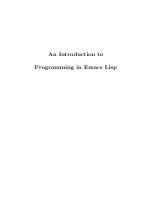chivers - introduction to programming with fortran (springer, 2006)
Bạn đang xem bản rút gọn của tài liệu. Xem và tải ngay bản đầy đủ của tài liệu tại đây (1.37 MB, 599 trang )
Introduction to Programming with Fortran
Ian D. Chivers and Jane Sleightholme
Introduction to
Programming with
Fortran
With Coverage of Fortran 90, 95, 2003, and 77
Ian D. Chivers, BSc, PGCEd, MSc, MBCS Jane Sleightholme, MSc, MBCS
Rhymney Consulting Kings College London
UK UK
British Library Cataloguing in Publication Data
A catalogue record for this book is available from the British Library
Library of Congress Control Number: 2005931518
ISBN-10: 1-84628-053-2 eISBN 1-84628-054-0 Printed on acid-free paper
ISBN-13: 978-1-84628-053-5
© Springer-Verlag London Limited 2006
Apart from any fair dealing for the purposes of research or private study, or criticism or review,
as permitted under the Copyright, Designs and Patents Act 1988, this publication may only be
reproduced, stored or transmitted, in any form or by any means, with the prior permission in
writing of the publishers, or in the case of reprographic reproduction in accordance with the
terms of licences issued by the Copyright Licensing Agency. Enquiries concerning reproduction
outside those terms should be sent to the publishers.
The use of registered names, trademarks, etc. in this publication does not imply, even in the
absence of a specific statement, that such names are exempt from the relevant laws and
regulations and therefore free for general use.
The publisher makes no representation, express or implied, with regard to the accuracy of the
information contained in this book and cannot accept any legal responsibility or liability for any
errors or omissions that may be made.
Printed in the United States of America (MVY)
987654321
Springer Science+Business Media
springeronline.com
Acknowlegement
The material in the book has evolved firstly from our combined experience of
working in Computing Services within the University of London at
• King's College, IDC (1986–2002) and JS (1985 to date)
• Chelsea College, JS (1978–1985)
• Imperial College, IDC (1978–1986)
in the teaching, advice and support of Fortran and related areas, and secondly in
the provision of commercial training courses. The following are some of the or-
ganisations we've provided training for:
• AWE, Aldermaston.
•
Centre for Ecology and Hydrology, Wallingford.
•
Environment Agency, Worthing.
•
The Met Office, Bracknell and Exeter.
•
QinetiQ, Farnborough.
•
Rolls Royce, Derby.
•
Veritas DGC Ltd., Crawley.
•
Westland Helicopters, Yeovil.
The examples in the book are based on what will work with compilers that support
the Fortran 90 and 95 standards and also support ISO TR 15580 and 15581. At the
time of writing this book there are no compilers that fully support the Fortran 2003
standard.
Thanks are due to:
•
The staff and students at King's College, Chelsea College and Imperial
College.
•
The people who have attended the commercial courses. Its been great fun
teaching you and things have been very lively at times.
•
The people on the Fortran 90 list and comp.lang.fortran. Access to the ex
-
pertise of several hundred people involved in the use and development of
Fortran on a daily basis across a wide range of disciplines is inestimable.
•
The people at NAG for the provision of the Fortran 95 compilers and Nag
Tools on the enclosed cd.
•
The staff and facilities at PTR Associates. It is a pleasure training there.
•
The patience of our families during the time required to develop the
courses upon which this book is based and whilst preparing the cam
-
era-ready copy.
• Finally Rebecca Mowat, Joanne Cooling, Helen Desmond and Beverley
Ford at Springer for their enthusiasm and encouragement!
Our King's home page is:
• />All of the program examples can be found there.
If you would like to contact us our email addresses are:
Ian D Chivers:
Jane Sleightholme:
vi Acknowledgement
Contents
1 Overview 1
2 Introduction to Computer Systems 9
2.1 The core of a computer system 10
2.1.1 Central processor unit — CPU 10
2.1.2 Memory 10
2.1.3 Bus 10
2.2 Other components of a computer system 11
2.2.1 Disks 11
2.2.2 Others 11
2.3 Software 12
2.4 Problems 13
2.5 Bibliography 13
3 Introduction to Operating Systems 15
3.1 History of operating systems 16
3.1.1 The 1940s 16
3.1.2 The 1950s 16
3.1.3 The 1960s 16
3.1.4 The 1960s and 1970s 16
3.1.5 The 1970s, 1980s, and 1990s 17
3.2 Networking 17
3.3 Problems 18
3.4 Bibliography 18
4 Introduction to Using a Computer System 19
4.1 Files 20
4.2 Editors 20
4.3 Single-user systems . . . 20
4.4 Networked systems . . . 20
4.5 Multiuser systems. . . 21
4.6 Other useful things to know 21
4.7 Common methods of using computer systems to develop Fortran
programs 22
4.8 Bibliography 23
5 Introduction to Problem Solving 25
5.1 Natural language . . . 26
5.2 Artificial language 27
5.2.1 Notations 27
5.3 Resumé 27
5.4 Algorithms 28
5.4.1 Top-down 28
5.4.2 Bottom-up 28
5.4.3 Stepwise refinement 29
5.4.4 Modular programming 29
5.4.5 Object oriented programming 29
5.5 Systems analysis and design 30
5.5.1 Problem definition 30
5.5.2 Feasibility study and fact finding 30
5.5.3 Analysis 31
5.5.4 Design 31
5.5.5 Detailed design 31
5.5.6 Implementation 31
5.5.7 Evaluation and testing 31
5.5.8 Maintenance 32
5.6 Conclusions 32
5.7 Problems 32
5.8 Bibliography 33
6 Introduction to Programming Languages 35
6.1 Some early theoretical work 36
6.2 What is a programming language? 36
6.3 Program language development and engineering 36
6.4 The early days 36
6.4.1 Fortran — The Early Days 37
6.4.2 Fortran 77 37
6.4.3 Cobol 37
6.4.4 Algol 38
6.5 Chomsky and program language development 39
6.6 Lisp 39
6.7 Snobol 40
6.8 Second-generation languages 40
6.8.1 PL/1 and Algol 68 40
6.8.2 Simula 40
6.8.3 Pascal 41
viii Contents
6.8.4 APL 41
6.8.5 Basic 41
6.8.6 C 41
6.9 Some other strands in language development 42
6.9.1 Abstraction, stepwise refinement and modules 42
6.9.2 Structured programming 42
6.9.3 Standardisation 42
6.10 Ada 43
6.11 Modula 43
6.12 Modula 2 44
6.13 Other language developments 44
6.13.1 Logo 44
6.13.2 Postscript, TeX and LaTeX 45
6.13.3 Prolog 45
6.13.4 SQL 45
6.13.5 ICON 46
6.14 Object orientated programming — OOP 46
6.14.1 Oberon and Oberon 2 46
6.14.2 Smalltalk 47
6.14.3 C++ 48
6.14.4 Java 48
6.14.5 Visual Basic 49
6.14.6 C# 49
6.15 Fortran 90 50
6.16 Fortran 1995 51
6.17 ISO technical reports TR15580 and TR15581 52
6.18 Fortran 2003 52
6.19 DTR 19767 enhanced module facilities 53
6.20 Internet resources . . . 54
6.20.1 Standards information 54
6.20.2 Fortran discussion lists 55
6.20.3 Other sources 55
6.21 Summary 56
6.22 Bibliography 56
7 Introduction to Programming 63
7.1 Language strengths and weaknesses 64
7.2 Elements of a programming language 64
7.2.1 Data description statements 65
7.2.2 Control structures . . . 65
7.2.3 Data-processing statements 65
7.2.4 Input and output (I/O) statements 65
7.3 Variables — name, type and value 68
Contents ix
7.4 Notes 70
7.5 Some more Fortran rules 71
7.6 Fortran character set 72
7.7 Good programming guidelines 73
7.8 Compilers 73
7.9 Program development 74
7.10 Problems 75
8 Arithmetic 77
8.1 Rounding and truncation 81
8.2 Time taken for light to travel from the Sun to Earth 83
8.3 The PARAMETER statement 84
8.4 Range, precision and size of numbers 85
8.5 Health warning: optional reading, beginners are advised to
leave until later 88
8.5.1 Selecting different INTEGER kind types 90
8.5.2 Selecting different REAL kind types 91
8.5.3 Specifying kind types for literal integer and real constants 91
8.5.4 Positional number systems 92
8.5.5 Bit data type and representation model 92
8.5.6 Integer data type and representation model 93
8.5.7 Real data type and representation model 93
8.5.8 IEEE 754 94
8.5.9 Testing the numerical representation of different kind types on a
system 94
8.5.10 Binary representation of different integer kind type numbers 98
8.5.11 Binary representation of a real number 100
8.5.12 Summary of how to select the appropriate kind type 101
8.6 Variable status 101
8.7 Summary 101
8.8 Problems 102
8.9 Bibliography 105
9 Arrays 1: Some Fundamentals 107
9.1 Tables of data 108
9.1.1 Telephone directory 108
9.1.2 Book catalogue 108
9.1.3 Examination marks or results 109
9.1.4 Monthly rainfall 109
9.2 Arrays in Fortran 110
9.3 The DIMENSION attribute 110
9.4 An index 111
9.5 Control structure 111
9.6 Monthly rainfall 111
x Contents
9.6.1 Example 1: Rainfall 112
9.7 People's weights 113
9.7.1 Example 2: Setting array size with a parameter 114
9.8 Summary 115
9.9 Problems 116
10 Arrays 2: Further Examples 119
10.1 Varying the array size at run time 120
10.2 Higher-dimension arrays 121
10.2.1 A map 121
10.2.2 Example 3: Sensible tabular output 123
10.2.3 Example 4: Average of three sets of values 124
10.2.4 Example 5: Booking arrangements in a theatre or cinema 125
10.3 Additional forms of the DIMENSION attribute and DO
loop statement 126
10.3.1 Example 6: Voltage from -20 to +20 volts 126
10.3.2 Example 7: Longitude from -180 to +180 127
10.3.3 Notes 127
10.4 The DO loop and straight repetition 127
10.4.1 Example 8: Table of temperatures 127
10.4.2 Example 9: Means and standard deviations 128
10.5 Summary 129
10.6 Problems 130
11 Whole Array and Additional Array Features 133
11.1 Terminology 134
11.1.1 Rank 134
11.1.2 Bounds 134
11.1.3 Extent 134
11.1.4 Size 134
11.1.5 Shape 134
11.1.6 Conformable 134
11.1.7 Array element ordering 134
11.2 Whole array manipulation 135
11.2.1 Assignment 135
11.2.2 Expressions 135
11.3 Array sections 138
11.3.1 Rank 1 array example 138
11.3.2 Rank 2 array example 138
11.4 Array constructors 140
11.4.1 Rank 1 array example — explicit values 140
11.4.1.1 Rank 1 array example and implied DO loop 141
11.4.1.2 Rank 1 array example and the DOT_PRODUCT intrinsic 141
11.4.2 Rank 1 example with step size of 2 in implied DO loop . . 143
Contents xi
11.4.3 Rank 1 array and the SUM intrinsic function 144
11.4.4 Rank 2 arrays and the SUM intrinsic function 145
11.5 Masked array assignment and the WHERE statement 146
11.5.1 Notes 147
11.6 The FORALL statement and FORALL construct 147
11.6.1 Syntax 147
11.6.2 Array element ordering and physical and virtual memory 148
11.7 Summary 148
11.8 Problems 149
11.9 Bibliography 149
12 Output of Results 151
12.1 Integers — I format or edit descriptor 152
12.2 Reals — F format or edit descriptor 155
12.2.1 Metric and imperial conversion 156
12.2.2 Overflow and underflow 156
12.3 Reals — E format or edit descriptor 158
12.3.1 Simple E format example 159
12.4 Spaces 160
12.5 Characters — A format or edit descriptor 160
12.5.1 Headings 161
12.6 Mixed type output in a FORMAT statement 162
12.7 Common mistakes 162
12.8 OPEN (and CLOSE) 163
12.8.1 The OPEN statement 163
12.8.2 Writing 164
12.9 Repetition 165
12.10 Some more examples 167
12.11 Implied DO loops and array sections for array output 168
12.12 Formatting for a line printer 170
12.12.1 Mechanics of carriage control 171
12.12.2 Generating a new line on both line printers and terminals 172
12.13 Timing of writing formatted files 173
12.14 Timing of writing unformatted files 174
12.15 Summary 176
12.16 Problems 176
13 Reading in Data 179
13.1 Reading from the terminal or keyboard versus reading
from files 180
13.2 Fixed fields on input 180
13.2.1 Integers and the I format 180
13.2.2 Reals and the F format 181
13.2.3 Reals and the E Format 182
xii Contents
13.3 Blanks, nulls and zeros 185
13.4 Characters 186
13.5 Skipping spaces and lines 187
13.6 Reading 187
13.7 File manipulation again 188
13.8 Reading using array sections 189
13.9 Timing of reading formatted files 190
13.10 Timing of reading unformatted files 191
13.11 Errors when reading 192
13.12 Summary 193
13.13 Problems 193
14 Files 195
14.1 Data files in Fortran 196
14.2 Summary of options on OPEN 198
14.3 More foolproof I/O 200
14.4 Summary 201
14.5 Problems 202
15 Functions 204
15.1 An introduction to predefined functions and their use 204
15.1.1 Example 1: Simple function usage 205
15.2 Generic functions 205
15.2.1 Example 2: The ABS generic function 206
15.3 Elemental functions 206
15.3.1 Example 3: Elemental function use 206
15.4 Transformational functions 206
15.4.1 Example 4: Simple transformational use 207
15.4.2 Example 5: Intrinsic DOT_PRODUCT use 207
15.5 Notes on function usage 207
15.6 Example 6: Easter 208
15.7 Complete list of predefined functions 210
15.7.1 Inquiry functions 210
15.7.2 Transfer and conversion functions 210
15.7.3 Computational functions 211
15.7.4 Array functions 211
15.7.5 Predefined subroutines 211
15.8 Supplying your own functions 212
15.8.1 Example 7: Simple user defined function 212
15.9 An introduction to the scope of variables and local
variables 214
15.10 Recursive functions 214
15.10.1 Example 8: Recursive factorial evaluation 215
Contents xiii
15.11 Example 9: Recursive version of GCD 216
15.12 Example 10: After removing recursion 217
15.13 Pure functions 218
15.14 Elemental functions 218
15.15 Internal functions 218
15.15.1 Example 11: Stirling's approximation 218
15.16 Resumé 219
15.17 Function syntax 220
15.18 Rules and restrictions 220
15.19 Problems 220
15.20 Bibliography 221
15.20.1 Recursion and problem solving 222
16 Control Structures 223
16.1 Selection among courses of action 224
16.1.1 The BLOCK IF statement 225
16.1.2 Example 1: Quadratic roots 227
16.1.3 Note 228
16.1.4 Example 2: Date calculation 228
16.1.5 The CASE statement 229
16.1.6 Example 3: Simple calculator 230
16.1.7 Example 4: Counting vowels, consonants, etc 231
16.2 The three forms of the DO statement 232
16.2.1 Example 5: Sentinel usage 232
16.2.2 CYCLE and EXIT 234
16.2.3 Example 6: e**x evaluation 234
16.2.4 Example 7: Wave breaking on an offshore reef 235
16.3 Summary 237
16.3.1 Control structure formal syntax 237
16.4 Problems 238
16.5 Bibliography 240
17 Characters 241
17.1 Character input 243
17.2 Character operators 244
17.3 Character substrings 245
17.4 Character functions 247
17.5 Collating sequence 248
17.6 Summary 250
17.7 Problems 251
18 Complex 253
18.1 Example 255
18.2 Complex and kind type 256
18.3 Summary 256
xiv Contents
18.4 Problems 256
19 Logical 257
19.1 I/O 261
19.2 Summary 261
19.3 Problems 262
20 User Defined Types 263
20.1 Example 1: Dates 264
20.2 Type definition 264
20.3 Variable definition 265
20.4 Example 2: Address lists 265
20.5 Example 3: Nested user defined types 266
20.6 Problems 268
20.7 Bibliography 268
21 An Introduction to Pointers 269
21.1 Some basic pointer concepts 270
21.2 The ASSOCIATED intrinsic function 272
21.2.1 CVF 6.6C 272
21.2.2 Intel, Windows, 8.1 272
21.2.3 Lahey, Windows 5.70f 272
21.2.4 NAG, Windows, 4.2 273
21.2.5 Salford 4.6.0 273
21.3 Referencing A and B before assignment 273
21.3.1 CVF 274
21.3.2 Intel, Windows 8.1 274
21.3.3 Lahey, Windows 5.70f 275
21.3.4 NAG, Windows 4.2 275
21.3.5 Salford 4.6.0 275
21.4 The NULL intrinsic 275
21.5 Assignment via = 276
21.6 Singly linked list 278
21.7 Reading in an arbitrary quantity of numeric data 280
21.8 Arrays of pointers 283
21.9 Arrays of pointers and variable sized data sets — 1 284
21.10 Arrays of pointers and variable sized data sets — 2 285
21.11 Memory leak examples 285
21.12 Nonstandard pointer examples 288
21.13 Problems 293
22 Introduction to Subroutines 295
22.1 Example 1 296
22.1.1 Defining a subroutine 298
22.1.2 Referencing a subroutine 299
Contents xv
22.1.3 Dummy arguments or parameters and actual arguments . . 299
22.1.4 Intent 299
22.1.5 Local variables 299
22.1.6 Local variables and the SAVE attribute 300
22.1.7 Scope of variables 300
22.1.8 Status of the action carried out in the subroutine 300
22.2 Example 2 300
22.3 Example 3 — Quadratic example with interface blocks . . 301
22.4 Example 4 — Quadratic example and the CONTAINS statement . . 304
22.5 Why bother? 306
22.6 Summary 307
22.7 Problems 307
23 Subroutines: 2 309
23.1 More on parameter passing 310
23.1.1 Explicit-shape array 310
23.1.2 Assumed-shape array 310
23.1.3 Deferred-shape array 310
23.1.4 Automatic arrays 310
23.1.5 Assumed-size array — Fortran 77 style 310
23.1.6 Adjustable arrays — Fortran 77 style 311
23.2 Common code example 311
23.3 Explicit-shape example 311
23.4 Assumed-shape example 313
23.4.1 Notes 315
23.5 Characters arguments and assumed-length dummy arguments 315
23.6 Rank 2 and higher arrays as parameters 316
23.6.1 Explicit-shape dummy arrays 316
23.6.2 Assumed-shape dummy array arguments 319
23.6.3 Notes 320
23.6.4 Using the intrinsic functions MATMUL and TRANSPOSE 321
23.7 Automatic arrays and median calculation 322
23.7.1 Internal subroutines and scope 325
23.7.2 Timing the selection sort algorithm 325
23.7.2.1 Timing 326
23.8 Alternative median calculation algorithm 327
23.8.1 Timing 330
23.9 Recursive subroutines — Quicksort 332
23.9.1 Note — Interface blocks 336
23.9.2 Note — Recursive subroutine 337
23.9.3 Note — Flexible design 337
23.9.4 Note — Timing information 337
23.10 Summary 337
xvi Contents
23.11 Problems 338
23.12 Bibliography 340
23.13 Commercial numerical and statistical subroutine libraries 340
24 An Introduction to Modules 341
24.1 Modules for global data 342
24.2 Modules for precision specification and constant definition 343
24.2.1 Note 344
24.3 Modules for sharing arrays of data 345
24.4 Modules for derived data types 346
24.4.1 Person data type 347
24.5 Modules containing procedures — Quicksort example 349
24.6 Modules containing procedures — Statistics example 353
24.7 The solution of linear equations using Gaussian elimination 356
24.7.1 Notes 361
24.7.1.1 Module for kind type 361
24.7.1.2 Deferred-shape arrays 361
24.7.1.3 Intrinisic functions MAXVAL and MAXLOC 361
24.8 Notes on module usage and compilation 361
24.9 Summary 362
24.10 Problems 362
24.11 Bibliography 363
25 Converting from Fortran 77 365
25.1 Deleted features 366
25.2 Obsolescent features 366
25.2.1 Arithmetic IF 366
25.2.2 Real and double precision DO control variables 366
25.2.3 Shared DO termination and non-ENDDO termination 366
25.2.4 Alternate RETURN 367
25.2.5 PAUSE statement 367
25.2.6 ASSIGN and assigned GOTO statements 367
25.2.7 Assigned FORMAT statements 367
25.2.8 H editing 367
25.3 Better alternatives 367
25.4 Example 1 368
25.5 Example 2 378
25.6 Commercial conversion tools 379
25.6.1 NAG 379
25.6.2 Polyhedron 395
25.6.3 Original Fortran 66. 407
25.6.4 Fortran 77 Version. 407
25.6.5 Fortran 90 Version 408
25.7 Summary 409
Contents xvii
25.8 Problems 409
26 Case Studies 411
26.1 Using linked lists for sparse matrix problems 412
26.1.1 Inner product of two sparse vectors 413
26.2 Solving a system of first-order ordinary differential
equations using Runga–Kutta–Merson 417
26.2.1 Note: Alternative form of the ALLOCATE statement 424
26.2.2 Note: Automatic arrays 424
26.2.3 Note: Dummy procedure arguments 425
26.2.4 Keyword and optional arguments 425
26.3 Generic procedures 427
26.4 A function that returns a variable length array 434
26.5 Operator and assignment overloading 436
26.6 A subroutine to extract the diagonal elements of a matrix 437
26.7 Perfectly balanced tree 439
26.8 Pure function example 442
26.8.1 Pure constraints 442
26.9 Elemental function example 443
26.9.1 Elemental constraints 444
26.10 Elemental subroutine example 445
26.11 Date class 446
26.12 Graphics example — dislin 461
26.13 Problems 469
26.14 Bibliography 470
27 ISO TR 15580 — IEEE Arithmetic 473
27.1 History 474
27.2 IEEE 754 Specifications 476
27.2.1 Single precision floating point format 477
27.2.2 Double precision floating point format 479
27.2.3 Two classes of extended floating point formats 479
27.2.4 Accuracy requirements 479
27.2.5 Base conversion — Converting between decimal and binary floating
point formats and vice versa 479
27.2.6 Exception handling 480
27.2.7 Rounding directions 480
27.2.8 Rounding precisions 480
27.3 Resumé 480
27.4 ISO TR 15580 481
27.4.1 IEEE_FEATURES module 481
27.4.2 IEEE_EXCEPTIONS module 481
27.4.3 IEEE_ARITHMETIC module 483
27.4.3.1 IEEE data type selection 484
xviii Contents
27.4.3.2 General support enquiry functions 484
27.4.3.3 Rounding modes 485
27.4.3.4 Number classification 485
27.4.3.5 Arithmetic operations 487
27.5 Summary 488
27.6 Bibliography 488
27.6.1 Web-based sources 489
27.6.2 Hardware sources 490
27.6.3 Operating Systems 491
27.6.4 Java and IEEE 754 491
27.6.5 C and IEEE 754 492
28 ISO TR 15581 Allocatable Enhancements 493
28.1 Allocatable dummy array example 494
28.2 Allocatable function result example 497
28.3 Allocatable structure component example 499
28.4 Summary 499
28.5 Problem 499
29 Fortran 2003 and the Enhanced Module Facility 501
29.1 Derived type enhancements 502
29.2 Object oriented programming support 502
29.3 Data manipulation enhancements 502
29.4 Input/output enhancements 503
29.5 Interoperability with the C programming language 503
29.6 Procedure pointers 504
29.7 Scoping enhancements 504
29.8 Support for IEC 60559 (IEEE 754) exceptions and
arithmetic 504
29.9 Support for international usage: (ISO 10646) 504
29.10 Enhanced integration with the host operating system 505
29.11 The ASSOCIATE construct 505
29.12 Enhanced modules facility 505
29.13 Summary 506
30 Parallel Programming 507
30.1 MPI 508
30.2 Co–array Fortran 508
30.3 Openmp 508
30.4 PVM 509
30.5 HPF 509
30.6 Parallel programming and high-performance computing . . 509
30.6.1 Summary 510
31 Miscellaneous 511
Contents xix
31.1 Program development and software engineering 512
31.1.1 Modules 513
31.1.2 Programming style — Programs should be easy to read . . 513
31.1.3 Programming style — Programs should behave well 514
31.2 Data structures 514
31.3 Algorithms 514
31.4 Recursion 515
31.5 Structured programming and the GOTO statement 515
31.6 Efficiency, space-time trade-off 516
31.7 Program testing 516
31.8 Simple debugging techniques 516
31.9 Software tools 517
31.9.1 Cross referencing 517
31.9.2 Pretty print 517
31.9.3 NAGWare f90 Tools 517
31.10 Numerical software sources 517
31.10.1 Numerical Algorithms Group 518
31.10.2 Visual Numerics 518
31.10.3 Netlib 518
31.11 Coda 518
31.12 Bibliography: All sources (bar one) taken from
comp.software-eng. 518
31.12.1 Software engineering 518
31.12.2 Programming style 519
31.12.3 Software testing 519
31.12.4 Fun 519
A Glossary 520
B Sample Program Examples 530
C ASCII Character Set 534
D Intrinsic Functions and Procedures 535
E English and Latin Texts 568
F Coded Text Extract 569
G Formal syntax 570
H Compiler Options 575
Index 581
xx Contents
1
Overview
“I don't know what the language of the year 2000 will look like, but it will be
called Fortran.”
C.A.R. Hoare
Aims
The aims of the chapter are to provide a background to the organisation of the
book.
1 Overview
The book aims to provide coverage of a recommended subset of the full Fortran
language. The subset we have chosen is one that fits most closely with the theory
and practice of structured programming, data structuring and software engineering.
This book has been written for both complete beginners with little or no program
-
ming background and experienced Fortran programmers who want to update their
skills and move to a modern version of the language.
Chapters 2–4 provide a short background to computer systems and their use:
•
Chapter 2 looks at the basics of computer systems from the hardware
point of view.
•
Chapter 3 provides a short history of operating system developments and
looks at some commonly used operating systems.
• Chapter 4 looks at some of the fundamentals of using a computer system.
These three chapters provide information that will be very helpful in the longer
term for the successful use of computer systems for programming.
Chapters 5 and 6 provide a coverage of problem solving and the history and devel-
opment of programming languages. Chapter 5 is essential for the beginner as the
concepts introduced there are used and expanded on throughout the rest of the
book. Chapter 6 must be read at some point but can be omitted initially. Pro-
gramming languages evolve and some understanding of where Fortran has come
from and where it is going will prove valuable in the longer term:
•
Chapter 5 looks at problem solving in some depth, and there is a coverage
of the way we define problems, the role of algorithms, the use of both
top-down and bottom-up methods, and the requirement for formal systems
analysis and design for more complex problems.
•
Chapter 6 looks at the history and development of programming lan
-
guages. This is essential as Fortran has evolved considerably from its ori
-
gins in the mid-1950s, through the first standard in 1966, the Fortran 77
standard, the Fortran 90 standard, the Fortran 95 standard, TR 15580 and
TR 15581, Fortran 2003 and beyond. It helps to put many of the current
and proposed features of Fortran into context. Languages covered include
Cobol, Algol, Lisp, Snobol, PL/1, Algol 68, Simula, Pascal, APL, Basic,
C, Ada, Modula, Modula 2, Logo, Prolog, SQL, ICON, Oberon, Oberon
2, Smalltalk, C++, C# and Java.
Chapters 7 through 11 cover the major features provided in Fortran for numeric
programming in the first instance and for general purpose programming in the sec
-
2 Chapter 1
ond. Each chapter has a set of problems. It is essential that a reasonable range of
problems is attempted and completed, as it is impossible to learn any language
without practice:
•
Chapter 7 provides an introduction to programming with some simple
Fortran examples. For people with a knowledge of programming this
chapter can be covered fairly quickly.
•
Chapter 8 looks at arithmetic in some depth, with a coverage of the vari
-
ous numeric data types, expressions and assignment of scalar variables.
There is also a thorough coverage of the facilities provided in Fortran to
help write programs that work on different hardware platforms.
•
Chapter 9 is an introduction to arrays and DO loops. The chapter starts
with some examples of tabular structures that one should be familiar with.
There is then an examination of what concepts we need in a programming
language to support manipulation of tabular data.
• Chapter 10 takes the ideas introduced in chapters 8 and 9 and extends
them to higher-dimensioned arrays, additional forms of the DIMENSION
attribute and corresponding form of the DO loop, and the use of looping
for the control of repetition and manipulation of tabular information with-
out the use of arrays.
• Chapter 11 looks at more of the facilities offered for the manipulation of
whole arrays and array sections, ways in which we can initialise arrays us-
ing constructors, look more formally at the concepts we need to be able to
accurately describe and understand arrays, and finally look at the differ
-
ences between the way Fortran allows us to use arrays and the mathemati
-
cal rules governing matrices.
Chapters 9 through 11 provide a coverage of some of the more important features
and uses of arrays in the field of numerical problem solving. The framework pro
-
vided here is drawn upon in later chapters in the book with more complex and
realistic examples.
Chapters 12, 13 and 14 look at input and output (I/O) and file handling in Fortran.
An understanding of I/O is necessary for the development of so-called production,
non interactive programs. These are essentially fully developed programs that are
used repeatedly with a variety of data inputs and results:
•
Chapter 12 looks at output of results and how to generate something that
is more comprehensible and easy to read than what is available with free
format output and also how to write the results to a file rather than the
screen.
Overview 3
•
Chapter 13 extends the ideas introduced in Chapter 12 on output to cover
input of data, or reading data into a program and also considers file I/O.
•
Chapter 14 provides a coverage of files.
Chapter 15 introduces the first building block available in Fortran for the construc
-
tion of programs for the solution of larger, more complex problems. It looks at the
functions available in Fortran, the so-called intrinsic functions and procedures
(over 100 of them) and covers how you can define and use your own functions.
It is essential to develop an understanding of the functions provided by the lan
-
guage and when it is necessary to write your own.
Chapter 16 introduces more formally the concept of control structures and their
role in structured programming. Some of the control structures available in Fortran
are introduced in earlier chapters, but there is a summary here of those already
covered plus several new ones that complete our coverage of a minimal working
set.
Chapters 17 through 21 complete our coverage of the facilities for data typing and
structuring provided by Fortran, both predefined and user defined. Fortran has now
caught up with some of the major developments in the data-structuring area of the
last 20 years, which have been available in other languages for some time:
• Chapter 17 looks at the character data type in Fortran. There is a coverage
of I/O again, with the operators available — only one in fact.
• Chapter 18 looks at the last numeric data type in Fortran, the complex
data type. This data type is essential to the solution of a small class of
problems in mathematics and engineering.
•
Chapter 19 looks at the logical data type. The material covered here helps
considerably in increasing the power and sophistication of the way we use
and construct logical expressions in Fortran. This proves invaluable in the
construction and use of logical expressions in control structures.
•
Chapters 20 looks at user-defined data types. This introduces another ma
-
jor new feature of Fortran. Previous versions of the language lacked any
facilities in this area. This meant that in many applications earlier versions
of Fortran were not the language of first choice for many people.
•
Chapter 21 looks at the dynamic data-structuring facilities now available
in Fortran. Examples are drawn from a range of sources.
These chapters conclude coverage of the data-structuring facilities provided by
Fortran. There are problems that will require facilities not provided, but it is sur
-
prising what can be achieved with the set now provided in Fortran. The material
4 Chapter 1
covered is extended into more realistic examples when we look at the construction
of larger and more complex programs in the last few chapters in the book.
The next two chapters look at the second major building block in Fortran — the
subroutine. Chapter 22 provides a gentle introduction to some of the fundamental
concepts of subroutine definition and use and Chapter 23 extends these ideas.
Chapter 24 introduces the concept of a module and the range of things that it
brings to Fortran.
Chapter 25 looks at converting to modern Fortran. A number of examples are used
and several software tools are examined.
Chapter 26 has a number of case studies helping to pull together the ideas pre
-
sented in the earlier chapters.
Chapter 27 looks at ISO TR 15580 — IEEE Arithmetic.
Chapter 28 deals with ISO TR 15581 — Allocatable Enhancements
Chapters 29 covers the new features of Fortran 2003 and ISO/IEC DTR 19767,
Enhanced Module Facilities.
Chapter 30 examines parallel Fortran.
Chapter 31 ties up some loose ends. It looks at program development and software
engineering, modules, programming style, data structures, algorithms, structured
programming, recursion and recursion removal, efficiency in space and time, pro-
gram testing, simple debugging techniques, software tools and numerical software
sources. There is also coverage of the various internet resources available for For
-
tran.
Many of the chapters have annotated bibliographies. These often have pointers and
directions for further reading. The coverage provided cannot be seen in isolation.
The concepts introduced are by intention brief, and fuller coverage must be sought
where necessary.
There are several appendices:
•
Appendix A — This is a glossary which provides coverage of both the
new concepts provided by Fortran and a range of computing terms and
ideas.
•
Appendix B — Provides an example of a simple program in a number of
the languages described in the chapter on program language development.
There is also coverage of the standards that apply.
•
Appendix C — The ASCII character set.
Overview 5
•
Appendix D — Contains a list of all of the intrinsic procedures in Fortran
and includes a full explanation of each procedure with a coverage of the
rules and restrictions that apply and examples of use.
•
Appendix E — Contains the English and Latin text extracts used in one of
the problems in the chapter on characters.
•
Appendix F — Contains the coded text extract used in one of the prob
-
lems in Chapter 17.
•
Appendix G — Formal syntax
•
Appendix H — Sample compiler options
This book is not and cannot possibly be completely self-contained and exhaustive
in its coverage of the Fortran language. Our first intention has been to produce a
coverage of the features that will get you started with Fortran and enable you to
solve quite a wide range of problems successfully.
Fortran, like most languages, has features that are of relatively little use or make
the construction of larger-scale programs more difficult, especially when moving
between hardware platforms. We have deliberately avoided these features.
Another problem is backwards compatibility with Fortran 77. Existing Fortran 77
programs have to be maintained, and there is much in that language that is depre-
cated or obsolescent in terms of Fortran 95 and Fortran 2003.
We have aimed to introduce a working subset of the new language that emphasises
the better constructs provided in Fortran over its predecessors, Fortran 77 and For
-
tran 66.
All in all Fortran is an exciting language, and it has caught up with language de
-
velopments of the 1970s, 1980s, and 1990s.
A range of hardware platforms, operating systems and Fortran compilers were
used. These include:
•
DEC VAX under VMS and later Open VMS using the NAG Fortran 90
compiler.
•
DEC Alpha under Open VMS using the DEC/Compaq Fortran 90 com
-
piler.
•
PC under DOS and Windows, DEC/Compaq Fortran 90.
•
PC under DOS and Windows, DEC/Compaq/HP Fortran 95.
•
PC under DOS and Windows, NAG/Salford Fortran 90.
•
PC under DOS and Windows, Lahey Fujitsu Fortran 95 PRO 5.7.
6 Chapter 1
